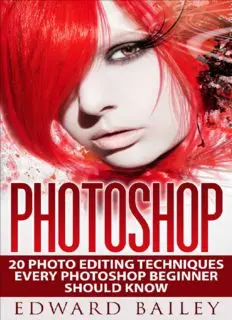
Photoshop: 20 Photo Editing Techniques Every Photoshop Beginner Should Know PDF
Preview Photoshop: 20 Photo Editing Techniques Every Photoshop Beginner Should Know
20 Photo Editing Techniques EVERY PHOTOSHOP BEGINNER SHOULD KNOW Edward Bailey Copyright © 2015 All rights reserved. No part of this book may be reproduced in any form without permission in writing from the author. Reviewers may quote brief passages in reviews. Disclaimer No part of this publication may be reproduced or transmitted in any form or by any means, mechanical or electronic, including photocopying or recording, or by any information storage and retrieval system or transmitted by email, without permission in writing from the publisher. While all attempts and efforts have been made to verify the information held within this publication, neither the author nor the publisher assumes any responsibility for errors, omissions, or opposing interpretations of the content herein. This book is for entertainment purposes only. The views expressed are those of the author alone, and should not be taken as expert instruction or commands. The reader of this book is responsible for his or her own actions when it comes to reading the book. Adherence to all applicable laws and regulations, including international, federal, state, and local governing professional licensing, business practices, advertising, and all other aspects of doing business in the US, Canada, or any other jurisdiction, is the sole responsibility of the purchaser or reader. Neither the author nor the publisher assumes any responsibility or liability whatsoever on the behalf of the purchaser or reader of these materials. Any received slight of any individual or organization is purely unintentional. Table of Contents Introduction Chapter 1: THE BEGINNING OF PHOTOSHOP Chapter 2: PHOTOSHOP THROUGH THE YEARS Chapter 3: ADVANTAGES AND LIMITATIONS Chapter 4: PHOTOSHOP TOOLS Chapter 5: PHOTOSHOP PALETTES Chapter 6: PHOTO EDITING WITH PHOTOSHOP Conclusion Introduction 6 FREE BONUS BOOKS INCLUDED IN THIS BOOK >>CLICK HERE<< First and foremost, I want to thank you for downloading the book, “20 Photo Editing Techniques Every Photoshop Beginner Should Know”. In this book, you will learn how to turn ordinary every day digital photographs into picture-perfect works of art, correcting imperfections, shading, color, and even physical balance, enriching your personal journey as a budding photojournalist or digital media arts hobbyist. Produce photographs that tell a story through the skillful use of tools for drawing, painting, retouching, selection and navigation; master simple techniques, such as cropping and resizing; introduce a new depth to your work with simple tools, such as the Magic Wand, Lasso, and Marquee to produce a whole new look, from simple to sophisticated, in the realm of digital color editing. Thanks again for downloading this book. I hope you enjoy it! >>“7 Proven Ways to Make Your ” Images Stand Out” get it for FREE NOW!<< Chapter 1: THE BEGINNING OF PHOTOSHOP >>CLICK Before You Get Started Reading HERE<< I have VERY important message that you MUST READ! I promise You it’s not spam and I am not trying to sell you anything! >>CLICK HERE NOW<< Now celebrating its 25th year, Photoshop has come a long way from its beginnings in 1987 when Thomas Knoll, PhD student from the University of Michigan, started working on a computer program designed for his Macintosh computer, which included showing grayscale photographs on a monochrome monitor for his thesis on the processing of digital images. He named the program “Display” and it got positive reviews from Thomas’ brother, John Knoll. John Knoll was then connected with film industry leaders on computer graphics production, Industrial Light and Magic (ILM), and American Academy Awards winners for motion picture and visual arts. On his brothers’ recommendation, Thomas took a 6-month sabbatical from his studies to develop what was to become the greatest innovation in the realm of digital color editing. The 6-month sibling collaboration and creative brainstorming yielded a full-fledged image-editing program, which was originally named “ImagePro”. Attempts to register the invention; however, encountered an obstacle; the name ImagePro had already been taken by another company, so Thomas renamed his baby “Photoshop”. Later that same year, he contracted Barneyscan, a small scanner manufacturing company, whose job was to be the distributor for 200 software copies, which already included color editing features with deliveries of their slide scanners. These features were later stripped from the first Adobe-delivered version. While Thomas was busy writing code, back in school in Ann Arbor, Michigan, John traveled south of California to Silicon Valley, the leading hub of giant high-tech corporations and silicon chip innovators, for the purpose of introducing the program. He conducted product demonstrations to Russell Brown, who held a function of Adobe’s art director, and to Apple company engineers, which were both a success. Brown did not waste even half a breath; Adobe turned around and bought the distribution license in September 1988. In February 1990, the first version of Photoshop 1.0 was designed for Macintosh. With each new Adobe version, improved color handling features swiftly evolved, with innovations incorporated into the program. Photoshop was quickly catapulted to fame and became known as the gold standard in the digital color editing industry. Now, Photoshop enjoys an almost exclusive popularity in color editing, changing in part of speech, and has become a neologism. Adobe Photoshop - the program (noun) That image needs to be “photoshopped” before release. (verb) Please do not pass any “photoshopped” images for your assignment. (adjective) Even with these, Photoshop demonstrates its versatility and more so in color image editing.
